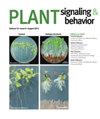施氮通过增强渗透平衡、活性氧清除和油菜幼苗光合作用缓解盐胁迫
IF 2.8
4区 生物学
Q3 BIOCHEMISTRY & MOLECULAR BIOLOGY
引用次数: 8
摘要
施氮可以缓解作物的盐胁迫,但具体的生理机制尚不清楚。因此,本研究通过盆栽试验,探讨不同施氮量(0、0.15、0.30和0.45 g·kg−1)对不同氯化钠浓度(1.5、3.5、5.5和7.5 g·kg−1)土壤中油菜籽幼苗生长参数、渗透调节、活性氧清除和光合作用的影响。结果表明,施氮可以缓解盐对油菜生长的抑制作用,提高油菜抗氧化酶活性和非酶物质、K+、可溶性蛋白、可溶性糖和脯氨酸的含量。活性氧清除系统、渗透调节系统指标与光合作用指标之间存在显著相关。因此,适量施氮可以促进盐胁迫下油菜籽幼苗的生长发育,加速活性氧的清除,维持渗透平衡,促进光合作用。本研究将进一步加深对施氮缓解作物盐胁迫机理的认识。本文章由计算机程序翻译,如有差异,请以英文原文为准。
Nitrogen application alleviates salt stress by enhancing osmotic balance, ROS scavenging, and photosynthesis of rapeseed seedlings (Brassica napus)
ABSTRACT Nitrogen application could alleviate salt stress on crops, but the specific physiological mechanism is still unclear. Therefore, in this study, a pot experiment was conducted to explore the effects of different application rates of nitrogen (0, 0.15, 0.30, and 0.45 g·kg−1) on the growth parameters, osmotic adjustment, reactive oxygen species scavenging, and photosynthesis of rapeseed seedlings planted in the soils with different concentrations of sodium chloride (1.5, 3.5, 5.5, and 7.5 g·kg−1). The results showed that nitrogen could alleviate the inhibition of salt on rapeseed growth, and improve the antioxidant enzyme activities and the contents of non-enzymatic substances, K+, soluble protein (SP), soluble sugar (SS), and proline. Besides, there was a significant correlation between the indexes of active oxygen scavenging system, osmoregulation system, and photosynthesis. Therefore, applying appropriate amount of nitrogen can promote the growth and development of rapeseed seedlings under salt stress, accelerate the scavenging of reactive oxygen species, maintain osmotic balance, and promote photosynthesis. This study will improve our understanding on the mechanism by which nitrogen application alleviates salt stress to crops.
求助全文
通过发布文献求助,成功后即可免费获取论文全文。
去求助
来源期刊

Plant Signaling & Behavior
Agricultural and Biological Sciences-Plant Science
CiteScore
6.00
自引率
3.40%
发文量
111
期刊介绍:
Plant Signaling & Behavior, a multidisciplinary peer-reviewed journal published monthly online, publishes original research articles and reviews covering the latest aspects of signal perception and transduction, integrative plant physiology, and information acquisition and processing.
 求助内容:
求助内容: 应助结果提醒方式:
应助结果提醒方式:


